Paramecium Caudatum – the Most Complex of the Simplest
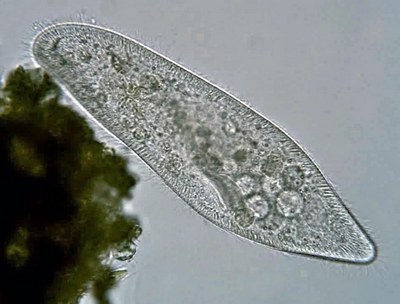
Content:
Life on our planet is characterized by an incredible variety of all kinds of living organisms, sometimes having an incredibly complex structure. All this diversity of life: from the simplest insects and plants to us, people (the most «complex organisms») consist of cells, these small bricks of living matter. If a human is the crown of biological evolution, then it will be very interesting to investigate its beginning: the simplest unicellular organisms which at the dawn of history became the founders of all life. The paramecium caudatum (along with amoeba) is one of the most famous simple unicellular creatures. What are the characteristics of the paramecium? What do paramecia eat? How do paramecia reproduce? Read on about all this below.
Definition and Characteristics
Paramecium caudatum is not at all one simple single-celled organism; there are more than 7 thousand different types of ciliates behind this name.
All paramecia can regulate the pressure of the internal environment of their body. They are assisted by two contractile vacuoles in this case. These vacuoles compressed and unclenched, thus expelling excess fluid from the body of the paramecium.
Paramecium size varies from 1 to 5 tenths of a millimeter.
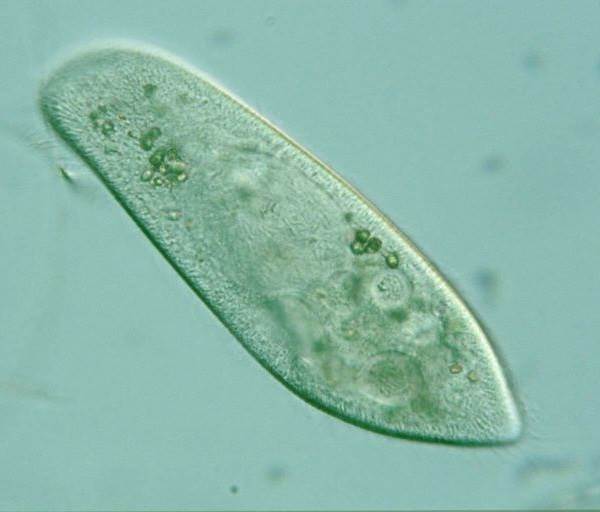
Although paramecium caudatum is the simplest single-celled creature, that is, its entire body consists of only one cell, nevertheless, it has the ability to breathe, eat, reproduce, and move independently. Moreover, paramecium caudatum is the most complex among other simple single-celled organisms.
Paramecia are eukaryotes. In contrast to prokaryotic organisms, such as bacteria and archaea, eukaryotes have well-organized cells. These cells have complex organelles:
- The contractile vacuoles already mentioned by us, responsible for the level of pressure inside the cell.
- Food vacuoles – they are responsible for food processing and serve as a stomach for ciliates.
- Anal pore, this is a hole in the hind limb of the ciliates, which is responsible for the release of digestive waste.
- The mouth, which is a recess in the cell membrane. Paramecia capture bacteria and other food with its help.
How do paramecia eat? They capture organic particles inside their body.
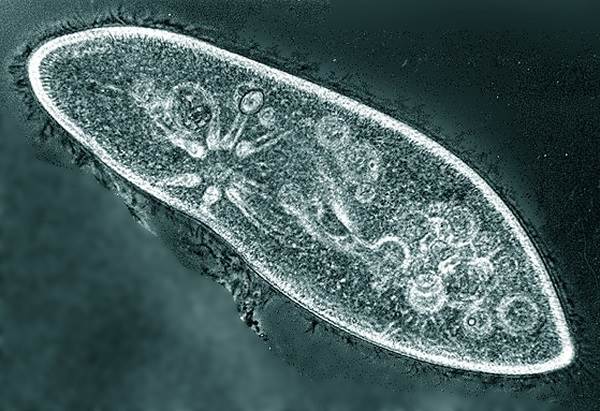
Paramecium caudatum under a microscope.
How do paramecia breathe? Paramecia breathe not with the mouth, but with the whole body: oxygen enters the cytoplasm through the integument of the cell, where it oxidizes organic substances, converts them into carbon dioxide, water, and other compounds.
There are two nuclei in paramecium cell. This is another amazing feature of the paramecia, which makes it “the most complex of the simplest”. One of the nuclei is large, it is called a macronucleus, and the second small, respectively, is called a micronucleus. Both nuclei store the same information. However, if a large nucleus is constantly in operation and its information is constantly being used, it means that it can be damaged. If such damage happens, then for this case the second small nucleus is provided. The second nucleus serves as a kind of reserve in case of failure of the main nucleus.
Structure
Despite the external simplicity, the structure of the paramecia is by no means simple. It is protected by a thin elastic shell outside, which also helps the body of the paramecia to maintain a constant shape. Protective supporting fibers of the paramecia are located in a layer of dense cytoplasm, which is adjacent to the membrane.
Besides, various microtubules, alveoli cisterns, basal bodies with cilia, fibrils, and other organelles are included in the cytoskeleton of paramecia.
Due to the presence of the cytoskeleton, paramecium, unlike an amoeba, cannot arbitrarily change the shape of its body.
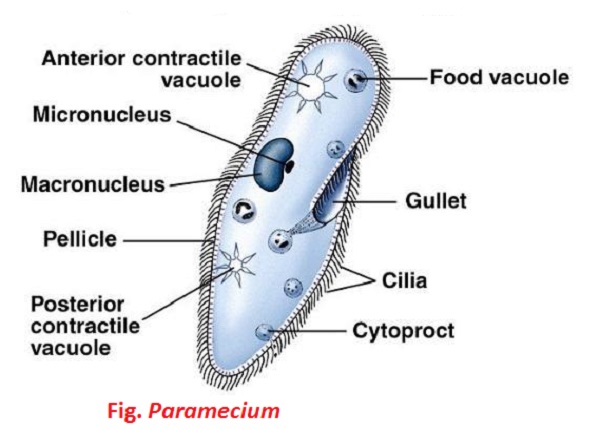
Classification
The structure of the paramecia depends on its class. So there are two classes of the paramecia:
- ciliary ciliates,
- sucking ciliates.
Ciliary Ciliates
They are named so because their body is covered with small eyelashes, which are also called cilia. The length of the eyelash is not more than 0.1 micrometers. Eyelashes themselves are a bundle of fibrils, which are filiform proteins.
Each ciliary ciliates can have several thousand of eyelashes. The paramecium movement is also carried out using eyelashes.
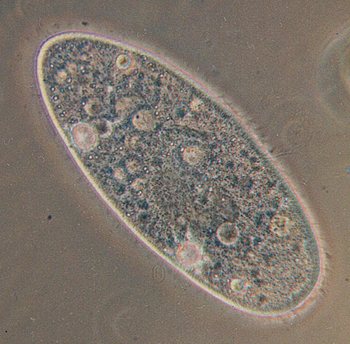
Sucking Ciliates
Sucking ciliates don’t have not only cilia but also the mouth, pharynx, and digestive vacuoles. Yet they have peculiar tentacles, which are plasma tubes. These tentacle tubules play the role of the mouth and pharynx, as they capture and conduct nutrients into the endoplasm of the cell.
Sucking ciliates can’t move without eyelashes. However, they don’t need it, having a special suction cup they attach to the skin of some crab or fish and live on them. There are only a few dozen species of sucking ciliates against thousands of species of ciliary ciliates.
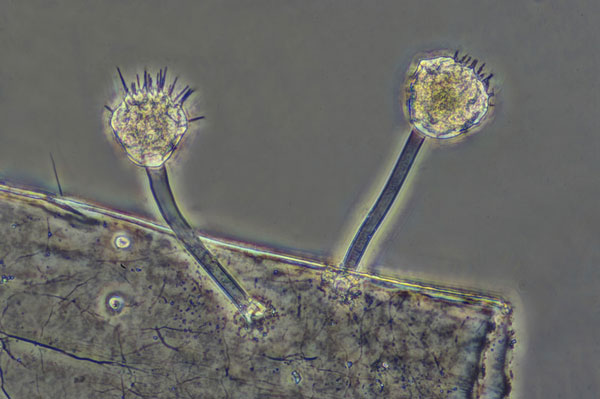
Habitat
Paramecia usually live in shallow freshwater ponds with stagnant water and rotting organic matter. They need stagnant water so as not to overcome the force of the current that will blow them, so there are no ciliates in the rivers. The Sun warms up the water sufficiently, and rotting organic matter serves as a source of their food.
Yet the ciliates do not like saltwater, so they don’t live in the seas and oceans.
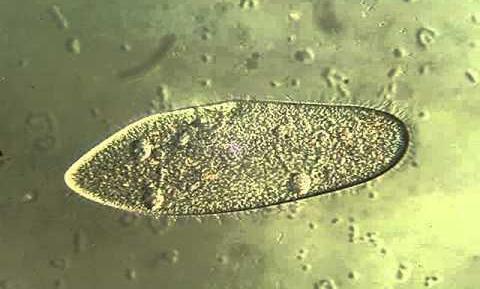
Diet
The nutrition of the paramecium depends on its class. So the sucking ciliates are genuine predators of the unicellular world: the source of their food is other smaller unicellular organisms. Sucking ciliates grab other unicellular organisms with their tentacles. Initially, the prey is captured by one tentacle, and then other “brothers” come up to the table. Tentacles dissolve the cell membrane of the victim and absorb it inside.
Yet the ciliary ciliates are “vegetarians” in this regard. The source of their food is usually unicellular algae. They are captured by the oral recesses, enter the esophagus, and then to the digestive vacuoles. Processed food is thrown out through the anal pore.
Reproduction
How do paramecium reproduce? Paramecium reproduction can be both sexual and asexual – through cell division.
- Sexual reproduction: two ciliates merge on the side surfaces, while the membranes between the fused surfaces dissolve, and cytoplasmic bridge forms. Cells exchange nuclei through this bridge. Large nuclei completely dissolve, and small ones divide twice. Then from the obtained four nuclei, three disappears, and the remaining nucleus is again divided into two. The exchange of the remaining nuclei occurs along the cytoplasmic bridge. Newly born nuclei arise from the resulting material, both large and small.
- The asexual reproduction of ciliates through division is much simpler. Both nuclei of the cell are divided into two, like other organelles. Thus, two ciliates are formed from one, each with a complete set of necessary organelles.
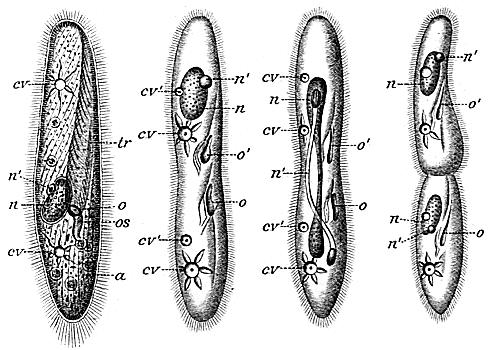
Functions
Paramecia, as well as other simple organisms, perform many important biological functions. They destroy many types of bacteria and serve as food for small invertebrate organisms. Sometimes they are specially bred as food for the fry of some aquarium fish.
References and Further Reading
- FOISSNER Wilhelm, BERGER Helmut, and KOHMANN Fritz (1994). Taxonomische und okologische Revision der Ciliaten des Saprobiensystems. Band III: Hymenostomata, Prostomatida, Nassulida. Informationsberichte des Bayerischen Landesamtes fur Wasserwirtschaft. p. 112.
- Jump up to: a b Wichterman, R. (2012-12-06). The Biology of Paramecium. Springer Science & Business Media. p. 38. ISBN 978-1-4757-0372-6.
- Patterson, D. J. (1980). “Contractile Vacuoles and Associated Structures: Their Organization and Function”. Biological Reviews. 55 (1): 3. doi:10.1111/j.1469-185X.1980.tb00686.x. ISSN 1469-185X.
- “Paramecium”. Microbus. Retrieved 17 April 2018.
- Lynn, Denis. The ciliated protozoa: characterization, classification, and guide to the literature. Springer, 2010. 279.

Author: Pavlo Chaika, Editor-in-Chief of the journal Poznavayka
When writing this article, I tried to make it as interesting and useful as possible. I would be grateful for any feedback and constructive criticism in the form of comments to the article. You can also write your wish/question/suggestion to my mail pavelchaika1983@gmail.com or to Facebook.

